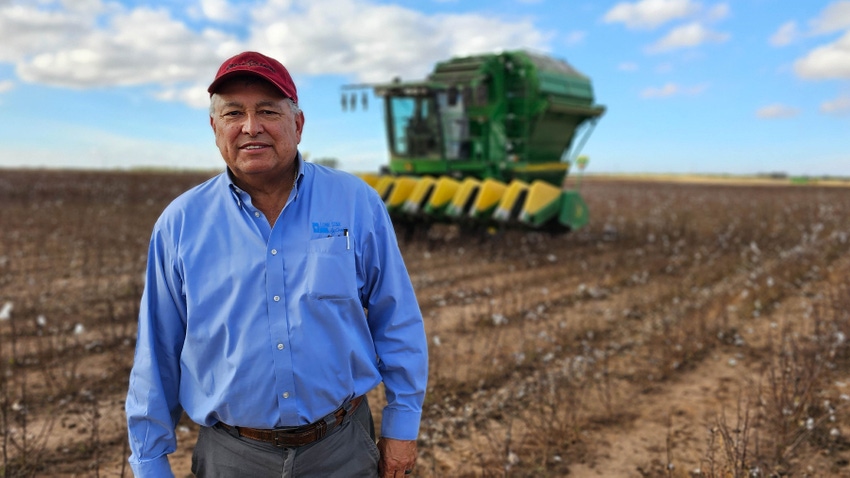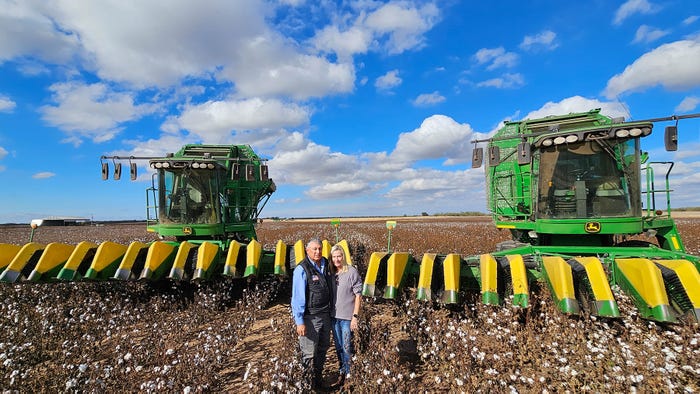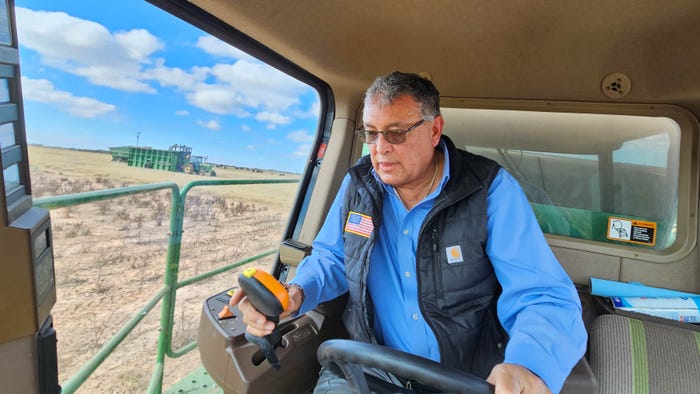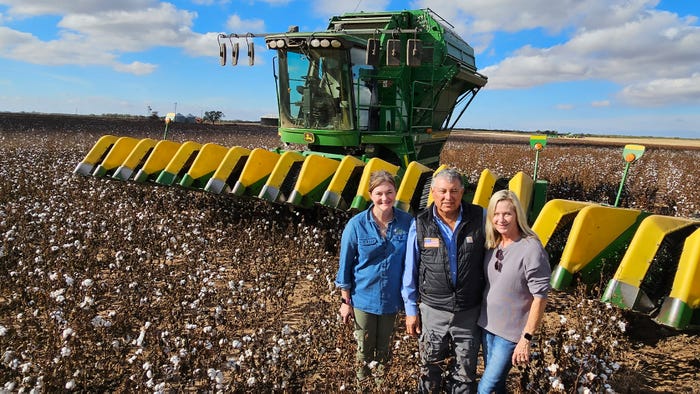
“I’m a skip row guy,” declared Roby, Texas, cotton producer Richard Gaona. It’s a practice he assures “always produces cotton.”
Gaona would know. He’s been producing cotton on the Texas Rolling Plains for nearly half a century.
“Let me put it this way, if it rains this winter and then we get spring rains, if we've got the moisture, it's going to be skip row,” he told Farm Press on his northeast Roby farm. “It always produces, no matter what, and will produce as much or more than planting solid, year in and year out.”
Gaona and his wife Judy farm primarily dryland cotton in a region that’s stingy with rainfall and generous with wind, dust and often triple-digit summer temperatures. For more than 45 years, sustainable production practices have enabled Gaona to grow cotton despite prevalent drought and limited irrigation.

Richard and Judy Gaona, Roby, Texas. (Photo by Shelley E. Huguley)
His tenacity, coupled with regenerative practices and quality cotton, as well as his industry advocacy, has earned Gaona the Southwest’s 2024 High Cotton award. Along with 3,000 dryland and 200 irrigated cotton acres, he farms 1,350 acres of wheat and hay, along with 700 pasture acres for his commercial Angus beef cattle.
Skip row cotton
Gaona describes skip row production as key to his cotton success, crediting it for decreasing farm inputs such as fertilizer. “The cotton utilizes moisture from the blank rows and that enhances the root system to produce a crop. It’s using what’s out there,” he said.
Within his region, northeast of Abilene, he said with the lack of timely rainfall, skip row cotton with a wheat rotation is beneficial. “You can get a half-inch or an inch of rain in the summer, and it will make a difference. Rotating with wheat works really well.”

Richard Gaona plants a wheat cover on his irrigated ground. (Photo by Shelley E. Huguley)
The wheat stubble aids moisture retention in the blank row. “You’ve got more roughage out there and there’s more nutrients in that soil because of the double crop,” he said.
But not all of his ground can sustain a wheat cover crop. “On dryland in this area, cover crops don’t work. If we plant (dryland) wheat, we’ll either cut it for hay or cut it for grain and then plant cotton the following year.”
Stimulating cotton’s root growth
Gaona is experimenting with new products, such as humic, to stimulate root growth. “My brother’s in the tree business and asked if we would try things he uses on trees. So, we started using humic and reducing our fertilizer.
“We were putting about 125 to 150 pounds per acre on dryland. We’ve backed down to 100 pounds. We went lower than that, but it doesn’t work, so we decided on about 90 to 100 pounds per acre of a 24-8-04 mixture with a little bit of zinc.”
Gaona’s brother can purchase humic at cost, about $2.50/gallon. “It’s a powder. We mix one gallon of water to one pound of humic. We put that in the fertilizer and side-dress our crops.
“They mix well. We don’t have any trouble. I can use my sprayer if I want to broadcast it. It’s something we’re using with the wheat also,” Gaona said.
On his drip ground, humic helps combat the salts in the water. “It helps the plant get the nutrients and leaves the salt.”
The brothers have also experimented with biochar on salt seeps, areas where cotton doesn’t emerge due to an oily top film. “The seed won’t germinate and come up,” Gaona said. “We’re getting more cotton up with the biochar and humic.”
But biochar is expensive. Gaona said as a hobby farmer, his brother can justify the expense. “But as a cotton farmer, I told him I can’t justify the cost. But if you can afford it, it works.”
Government program frustrations
Even though skip row has proven beneficial to cotton production, government programs don’t recognize it. On years that drought is probable, Gaona’s somewhat forced to plant every row. “The only reason I plant every row is because of the government programs. They are set up for solid planting and not for skip row. You get penalized for those .667 that you plant, and you lose 33% of it to those payments. It’s factored down.”

Richard Gaona and the Rolling Plains Cotton Growers are advocating for change to rules regarding skip row cotton coverage. (Photo by Shelley E. Huguley)
He, along with Rolling Plains Cotton Growers, are advocating for RMA to change the rules. “If you plant two-in-one skip row on 100 acres, that should be 100-row acres. We’re trying to conserve water, use less fertilizer, reduce wind and land damage. And I’ll take it to harvest more years than those with solid planting because it will make as much or more.
“On these dry years, disaster years, I’ve planted every row to work the program because that’s the way government programs and insurance are set up. But there has to be a product RMA could offer to help skip row guys.”
The 2023 crop is a great example. “It was one of those fluke deals. At planting, everything was right, so I planted two-in-one. In one night, it was over with.”
Tornadic June winds blew out his crop. “I’m going to get less insurance because of that skip row conversion factor and yield conversion factors,” he said.
The ‘23 crop took another hit. An early freeze snapped the not-yet defoliated cotton that remained, leaving the crop littered with dead vegetation and locked bolls.
Gaona, who didn’t harvest a crop in 2022, had little to harvest in 2023. He’s aware his insurance payments will be less. Despite this, he’s not deterred. “I’ll make it one way or another. I’ve been doing it for a long time and will continue.”
His tenacity and passion for doing what’s best for the land are things he learned from his late father, Jeronimo. His father, born in Mexico and who as a 12-year-old traveled as a migrant worker from South Texas to Washington State, changed his life’s course in the cotton fields of Fisher County, Texas. A boss and friend helped him transition from a temporary laborer to a U.S. citizen and eventually a Texas landowner, owning up to 1,400 acres. Gaona and his wife Judy live on and still farm land he purchased.
Terrace management
A practice Gaona adopted from his father is contour terracing. “This is the Rolling Plains, and we do farm on a contour. He always said take care of those terraces because that’s where you can slow down the water and keep it from washing away. Always run your rows with the contour and never farm downhill.”
Contour terracing helps increase irrigation and moisture conservation, Gaona said. Gaona beds up his rows rather than run a field cultivator and plant flat. “It’s got a ridge to slow it down. Where it’s flat planted, the water seems to get away,” he said. He also credits the practice for preventing the sand from blowing.
Gaona’s father believed terracing was also about being a good neighbor. He said you don’t want to wash out your neighbor’s crop.
Cotton variety
Quality and yield play a vital role in Gaona’s cotton variety selection, especially on his irrigated acres. He plants FiberMax and Stoneville field trials.
“I’ve tried all different varieties,” he said. “FiberMax has been the one that’s been consistent. The other varieties have good cotton, but FiberMax has been consistent as far as quality.”

Richard Gaona says he's planted several different varieties but that FiberMax performs best on his farms. (Photo by Shelley E. Huguley)
Last summer his dryland FiberMax endured tornadic winds, triple-digit temperatures and no summer rainfall and yet some remained harvestable. “It got some light rain (early fall), and it produced some good cotton.”
His preference is FiberMax 1832. On his irrigated fields, he plants 40,000 to 42,000 seeds per row acre. On his two-in-one skip row, he plants 30,000 to 32,000 seeds per row acre and 24,000 on his solid rows.
Regenerative practices
As technology has evolved, his practices have as well. “We’re going across it less than when I started. Used to, we ran breaking plows on terraces nearly every other year. We were chiseling. When we’d put down herbicide then we’d come back and list and then put fertilizer. We might even go back and plow it again.
“Now, it’s more chisel. If we’ve got wheat in rotation, then we’ll strip-till that. We won’t destroy the wheat stubble. We’ll strip-till, put fertilizer down and we’re done until planting.”
U.S. Cotton Trust Protocol
Gaona is enrolled in the U.S. Cotton Trust Protocol. He says it’s a source for textile mills, retailers and consumers to understand that as a cotton producer, he’s committed to regenerative cotton production. “We’ve got to get our message out that we are taking care of this land and trying to leave it in better shape than we found it,” -- a value he gleaned from his dad. “We’re trying to use less chemicals, less fertilizer.

Judy and Richard Gaona visit with Kevin Corzine, Stamford, center, and the Honorable Mike Conaway, right, at the 2023 Rolling Plains Cotton Growers fall meeting. (Photo by Shelley E. Huguley)
��“The people in urban areas aren’t realizing what we do, so if we can get our message out, I think it’s the best thing,” he said. “It’s important to let them know we’re trying to take care of this ground so we can produce food and fiber for them.”
Cotton industry leadership
Gaona credits his dad for much of his production success. “He was a good teacher.” Jeronimo also exemplified the importance of service, something Gaona has mimicked within his community and the cotton industry.
“Richard is the kind of leader that’s active in everything he does,” said Longworth Co-op Gin Manager Terry Coker, in his nomination letter. “Whether he’s advocating for kids on the school board, landowners in the community on the appraisal board, farmers through the USDA FSA, or ag borrowers through the farm credit system, he’s the kind you want on your side. He’s a wonderful friend and family man…”

Lauren Decker, Rolling Plains Cotton Growers executive director, left, with Richard and Judy Gaona. Decker nominated Gaona for the High Cotton award. (Photo by Shelley E. Huguley)
Dennis Cumbie, retired USDA-FSA county executive director, cites Gaona as a positive role model for young producers. “One of his best pieces of advice to young producers is ‘If you want to survive and thrive in farming, you need to focus on how to make a crop.’”
Lauren Decker, RPCG executive director, said Richard, a past RPCG president, goes above and beyond to represent local growers. “Whether it’s a farm bill forum, hosting staff from a congressional or administrative delegation or a political fundraiser, he’s willing to have a seat at the table and speak up for the interests of our growers. Leaders like Richard are incredibly important, and I am grateful to have him on our team.”
High Cotton winners
The other regional winners include the following: Southeast — Andy Wendland, Autaugaville, Ala.; Midsouth — Edward Greer, Rayville, La.; and West — Jerry Rovey, Buckeye, Ariz.
The High Cotton Award is sponsored by Americot, BASF Stonevilee/FiberMax, Deltapine, Dyna-Gro, Helena, John Deere, PhytoGen and Syngenta.
Read more about:
High CottonAbout the Author(s)
You May Also Like






